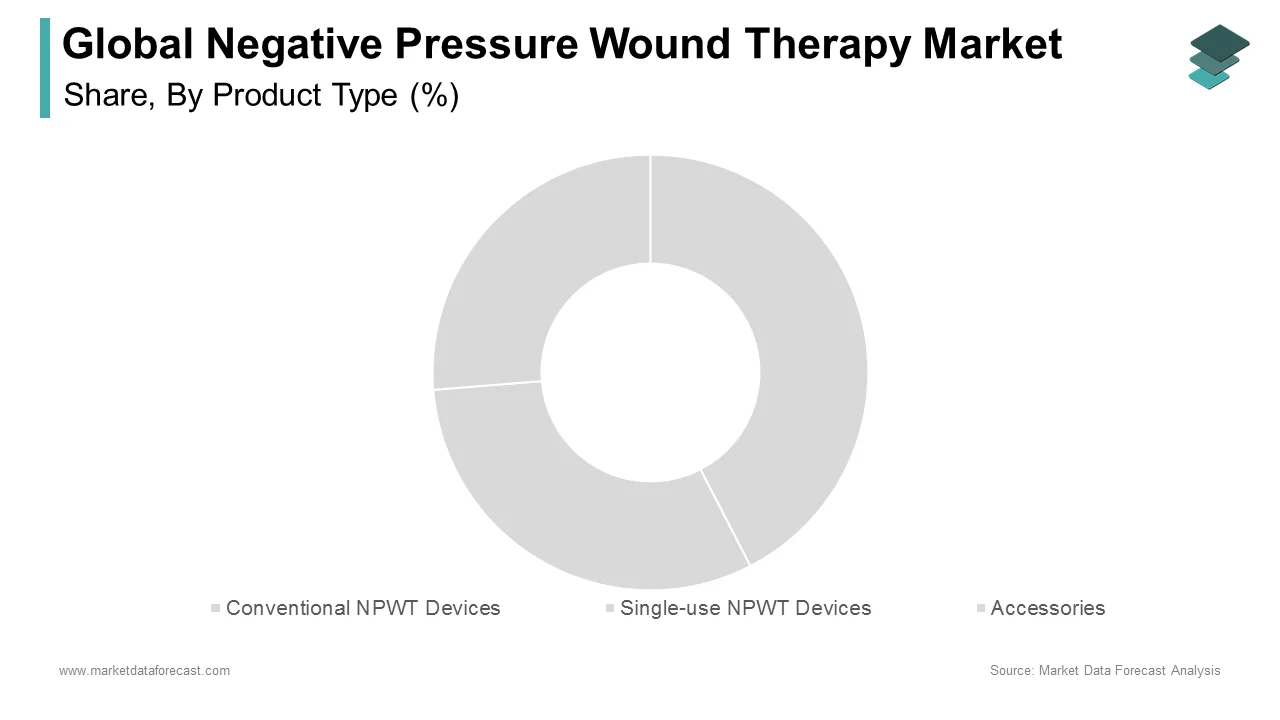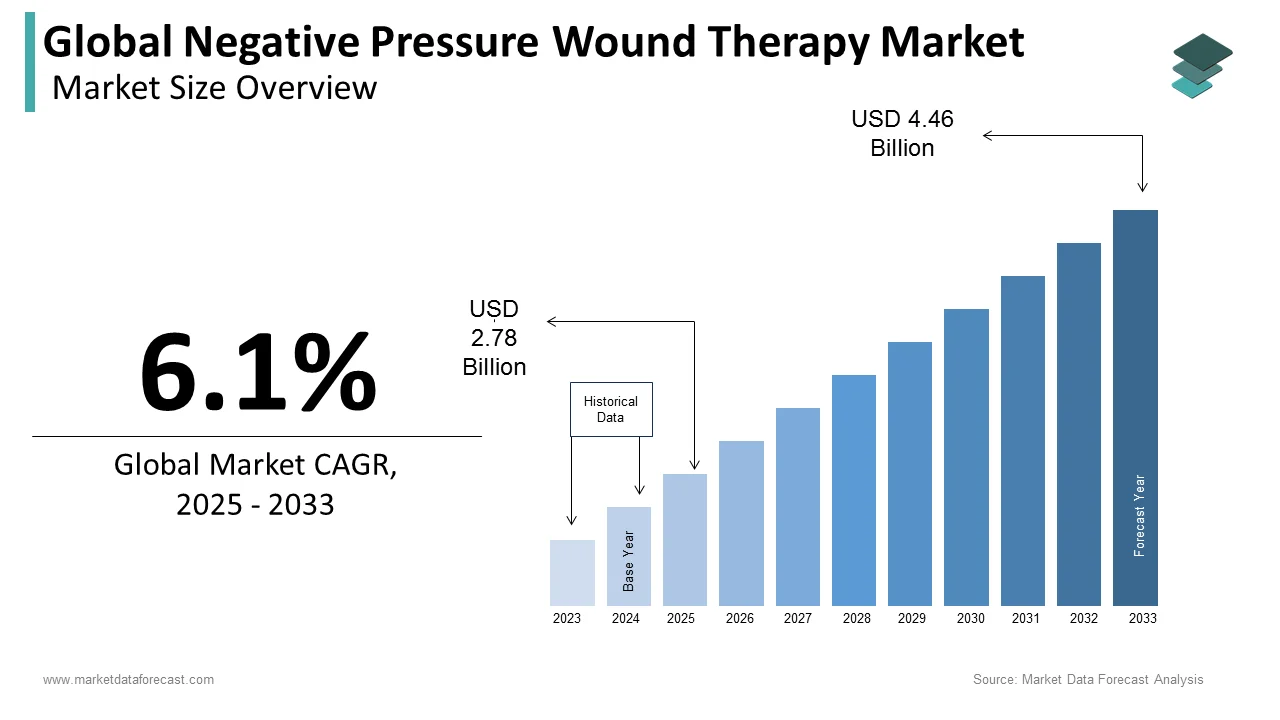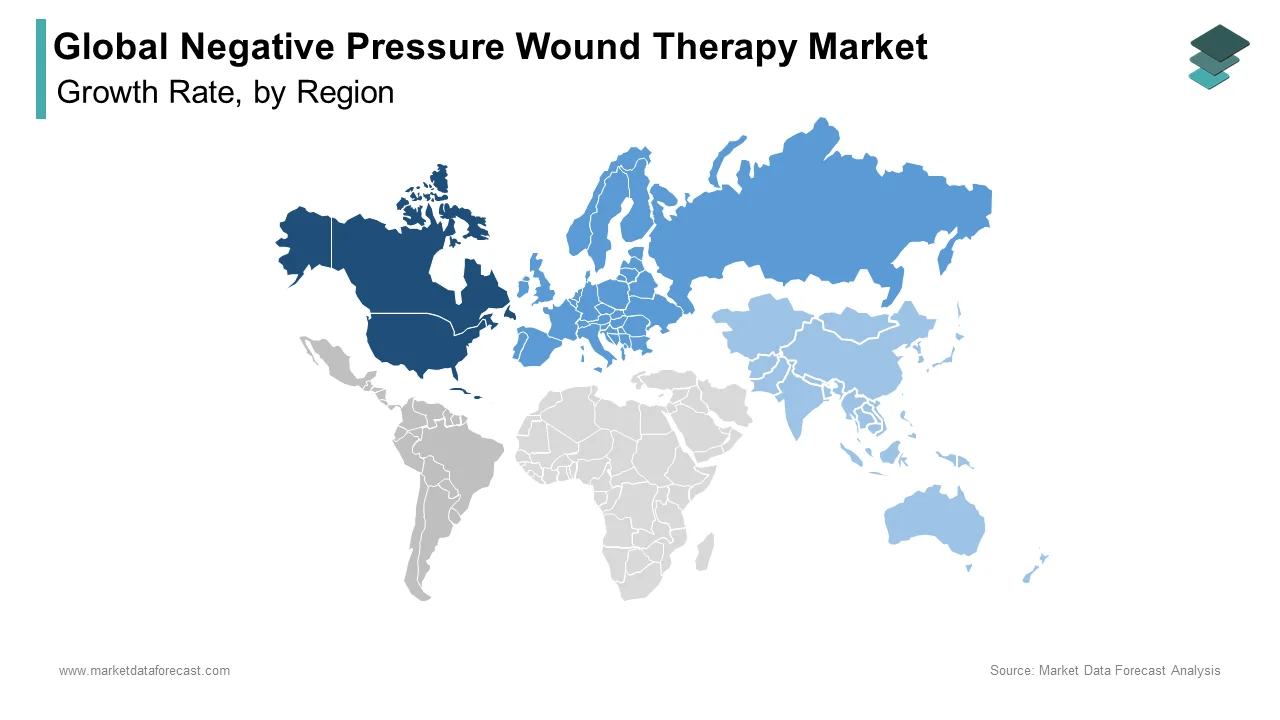Global Negative Pressure Wound Therapy Market Size, Share, Trends & Growth Forecast By Product Type, Wound Type, End-User and Region (North America, Europe, Asia-Pacific, Latin America, Middle East and Africa), Industry Analysis From 2025 To 2033.
Global Negative Pressure Wound Therapy Market Size
The size of the global negative pressure wound therapy market was worth USD 2.62 billion in 2024. The global market is anticipated to grow at a CAGR of 6.1% from 2025 to 2033 and be worth USD 4.46 billion by 2033 from USD 2.78 billion in 2025.
Negative pressure wound therapy is a preferred treatment option, especially for diabetic ulcers, pressure sores, postoperative wounds, and recurring chronic wounds such as leg ulcers. Negative pressure wound therapy (NPWT), also known as vacuum-aided closing, is a dressing device that constantly or intermittently adds negative pressure to the wound surface. This therapy is becoming more common for the treatment of both acute and chronic wounds. Conventional and single-use NPWT systems are commercially viable. However, their use depends on the cut's size and location, the patient's general health, and nutritional status. NPWT dressings are often checked every 48 hours, although this can be extended up to 2-6 weeks, depending on the seriousness of the wound.
MARKET DRIVERS
The growing number of patients who have diabetes worldwide is a significant factor driving the growth of the NPWT market.
The primary factor driving the growth of the global negative pressure wound therapy market is the rise in the diabetes provinces worldwide. According to the IDF (International Diabetics Federation) estimation, by 2040, the diabetic patient count will reach 642.0 million from 415.0 million in 2015. For wound recovery, diabetes, and associated ulcers (such as diabetic foot ulcers, venous ulcers, and pressure ulcers), acute and surgical wounds need appropriate and intensive treatment. Disposable, standalone, and compact NPWT systems allow quicker and more efficient recovery from these conditions. In addition, incisions will usually drain infections in the significant compartments and abscesses. Since incisions on the plantar surface heal slowly, a longer duration of immobilization is needed. This will increase demand for specialized wound care systems for drainage and quicker wound healing, which is expected to drive the global negative pressure wound therapy market.
In addition, the growing spending on chronic and surgical wounds, the increasing number of government measures to avoid SSIs, and a high incidence of cesarean sections in elderly mothers contributing to increased postoperative usage of NPWT devices are projected to fuel the global negative pressure wound therapy market growth over the forecast period.
Furthermore, the growing aging population is expected to fuel the growth rate of the NPWT market. With growing age, people are likely prone to various chronic diseases that may increase the risk of ulcers and other types of wounds. In such cases, NPWT procedures are used in the treatment procedures. The growing adoption of technological advancements in the manufacturing of NPWT devices is expected to boost market growth during the forecast period. The growing support from various governments and the increasing number of favorable reimbursement policies are predicted to result in the market's growth rate. Factors such as increasing awareness regarding the advantages associated with NPWT among healthcare providers and patients are anticipated to showcase a favorable impact on the market growth. In addition, the growing investments and funding from governmental and non-governmental organizations to conduct R&D to develop new NPWT technologies further propel the market growth.
MARKET RESTRAINTS
The high costs associated with harmful wound pressure therapy devices, the growing acceptance of disposable NPWT devices, and the development of other low-cost solutions for treating chronic and acute wounds are limiting the growth rate of the NPWT market.
In addition, poor penetration, uncertainties, threats associated with using harmful pressure wound therapy devices, and strict regulatory policies further inhibit market growth. Furthermore, the scarcity of skilled healthcare professionals, unfavorable reimbursement policies for NPWT devices in some of the counties, side effects associated with the usage of NPWT devices such as infection and bleeding, unavailability of NPWT devices in some of the countries, the presence of stringent regulatory environment for NPWT devices and poor awareness levels regarding the advantages of NPWT are further inhibiting the growth rate of the worldwide NPWT market.
REPORT COVERAGE
|
REPORT METRIC |
DETAILS |
|
Market Size Available |
2024 to 2033 |
|
Base Year |
2024 |
|
Forecast Period |
2025 to 2033 |
|
Segments Covered |
By Product Type, Wound Type, End-User, and Region |
|
Various Analyses Covered |
Global, Regional & Country Level Analysis, Segment-Level Analysis, Drivers, Restraints, Opportunities, Challenges; PESTLE Analysis; Porter’s Five Forces Analysis; Competitive Landscape, Analyst Overview of Investment Opportunities |
|
Regions Covered |
North America, Europe, Asia Pacific, Latin America, Middle East & Africa |
|
Market Leaders Profiled |
Acuity, Smith & Nephew, Mölnlycke Health Care AB, Convatec Group, Cardinal Health, Paul Hartmann AG, Deroyal, Lohmann & Rauscher International, Medela, Genadyne Biotechnologies, Triage Meditech, Talley Group, Alleva Medical, and Others. |
SEGMENTAL ANALYSIS
By Product Type Insights

During the forecast period, the conventional NPWT devices segment held the most significant worldwide market share in 2024. The growing adoption of conventional NPWT devices in emerging economies is one of the key factors propelling segmental growth. As a result, the domination of the conventional NPWT devices segment is estimated to continue throughout the forecast period.
On the other hand, the single-use NPWT devices segment has started picking up and is anticipated to showcase a healthy CAGR during the forecast period. This is because the adoption of single-use NPWT devices is growing among home care settings, majorly boosting the segment's growth rate. In addition, the increasing efforts from the key manufacturers of single-use NPWT devices to make them available at an affordable cost further favor segmental growth.
By Wound Type Insights
Based on wound type, the pressure ulcer segment accounted for a significant share of the global NPWT market in 2022. The rising adoption of NPWT devices to treat pressure ulcers contributes to the segment's growth. Therefore, during the forecast period, the pressure ulcers segment is anticipated to hold decent occupancy worldwide.
On the other hand, the diabetic foot ulcers segment is estimated to register the fastest CAGR among all the segments in the global market during the forecast period. The segment's growth is primarily driven by the increasing incidence of diabetes and growing adoption from healthcare providers to use NPWT to treat diabetic foot ulcers. Therefore, during the forecast period, the diabetic foot ulcer segment is predicted to have strong occupancy in the worldwide market.
By End-User Insights
Based on the end-user, the hospital segment had the largest share of the global NPWT market in 2024, and the segment's domination is expected to continue during the forecast period. The growing number of patients admitted to hospitals for wound care primarily boosts segmental growth.
On the other hand, the home care settings segment is forecasted to witness a healthy CAGR in the coming years, owing to the increasing adoption of NPWT devices in the home care settings.
REGIONAL ANALYSIS
North America had a significant share of the global negative pressure wound therapy market in 2024, and the region's domination is expected to continue during the forecast period.
The region's domination can be attributed to the increasing aging population and the growing prevalence of diabetes. For instance, according to the data published by the Centers for Disease Prevention and Control (CDC), 37.3 million people are living with diabetes. The presence of well-developed healthcare infrastructure, growing usage of NPWT devices, and increasing awareness among healthcare providers and patients regarding wound care further support the growth rate of the regional market. During the forecast period, the U.S. NPWT market is anticipated to hold a major share of the North American market.
During the forecast period, the European NPWT market is anticipated to hold a promising global market share and is expected to showcase a healthy CAGR in the coming years. The growing patient count who has diabetes, the increasing number of accidents across the European region, and developments in the healthcare infrastructure are some key factors propelling the market growth in the European region. For instance, an estimated 161,000 people died in the European Union, as per the statistics of Eurostat.
The APAC NPWT market is expected to grow at the fastest CAGR during the forecast period. The increasing prevalence of chronic diseases primarily drives the APAC market, and the presence of developing countries contributes to the NPWT market growth in the Asia-Pacific region. China accounted for a considerable share of the APAC market in 2024 and is estimated to be the fastest-growing country for NPWT worldwide. India is another promising market in this region and is expected to showcase a noteworthy CAGR during the forecast period. WHO says an estimated one million people annually have moderate burns in India.
The Latin American NPWT market is anticipated to showcase a steady CAGR during the forecast period owing to the increasing developments in the Latin American healthcare system and the increasing incidence of wounds. Brazil is anticipated to hold a significant share of the Latin American market in the coming years, followed by Mexico and Argentina.
The MEA NPWT market is expected to hold a moderate global market share during the forecast period. The increasing number of initiatives in favor of NPWT among the countries of MEA is one of the major factors supporting the market growth in MEA. As a result, countries such as UAE and Saudi Arabia are expected to project a healthy CAGR during the forecast period.
KEY MARKET PARTICIPANTS
Some of the companies that are playing a dominating role in the global NPWT market are Acuity, Smith & Nephew, Mölnlycke Health Care AB, Convatec Group, Cardinal Health, Paul Hartmann AG, Deroyal, Lohmann & Rauscher International, Medela, Genadyne Biotechnologies, Triage Meditech, Talley Group, Alleva Medical, Cork Medical, 4l Health, Carilex Medical, Chongqing Sunshine Medical Industry and Trading, Wuhan VSD Medical Science & Technology, Pensar Medical, and Haromed BVBA.
KEY MARKET HAPPENINGS
- In July 2018, ABTHERA ADVANCE was launched by Acelity, an open abdomen dressing in the US.
- In February 2018, in Europe, PICO & was launched by Smith and Nephew.
MARKET SEGMENTATION
This market research report on the global negative pressure wound therapy market has been segmented and sub-segmented based on product type, wound type, end-user, and region.
By Product Type
- Conventional NPWT Devices
- Single-use NPWT Devices
- Accessories
By Wound Type
- Surgical and Traumatic Wounds
- Ulcers
- Pressure Ulcers
- Venous Ulcers
- Diabetic Foot Ulcers
- Other Ulcer
- Burns
By End-User
- Hospitals
- Home care settings
- Other end users
By Region
- North America
- Europe
- Asia Pacific
- Latin America
- Middle East and Africa
Frequently Asked Questions
How much was the global negative pressure wound therapy market worth in 2024?
The global negative pressure wound therapy market size was valued at USD 2.62 billion in 2024.
Which region is growing the fastest in the global negative pressure wound therapy market?
During the forecast period, the Asia-Pacific region is estimated to grow at the fastest CAGR in the worldwide market.
Does this report include the impact of COVID-19 on the negative pressure wound therapy market?
The impact of COVID-19 on the global negative pressure wound therapy market has been included in this report.
What are the companies playing a leading role in the negative pressure wound therapy market?
Acelity, Smith & Nephew, Mölnlycke Health Care AB, Convatec Group, Cardinal Health, Paul Hartmann AG, Deroyal, Lohmann & Rauscher International, Medela, Genadyne Biotechnologies, Triage Meditech, Talley Group, Alleva Medical, Cork Medical, 4l Health, Carilex Medical, Chongqing Sunshine Medical Industry and Trading, Wuhan VSD Medical Science & Technology, Pensar Medical, and Haromed BVBA are some of the major players in the NPWT market.
Related Reports
Access the study in MULTIPLE FORMATS
Purchase options starting from
$ 2500
Didn’t find what you’re looking for?
TALK TO OUR ANALYST TEAM
Need something within your budget?
NO WORRIES! WE GOT YOU COVERED!
Call us on: +1 888 702 9696 (U.S Toll Free)
Write to us: sales@marketdataforecast.com


